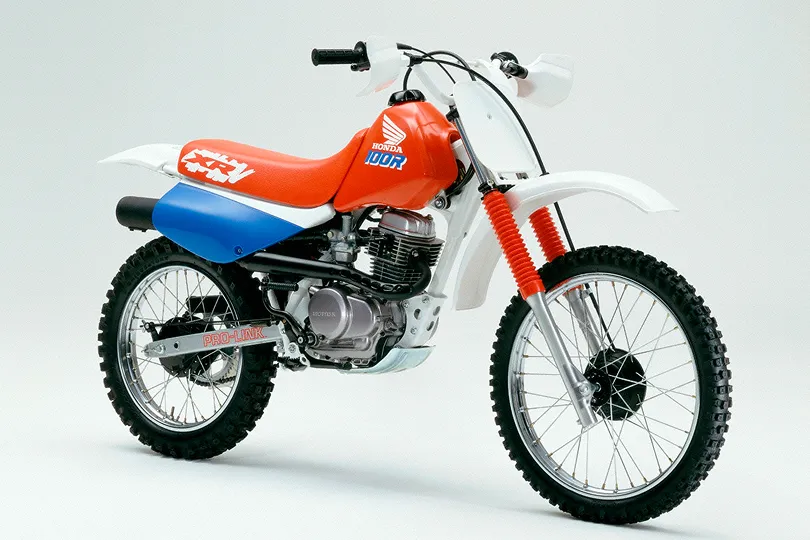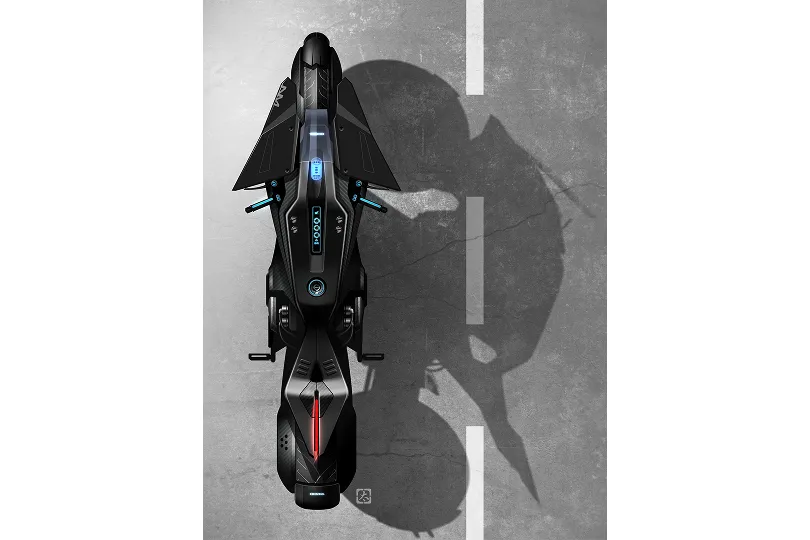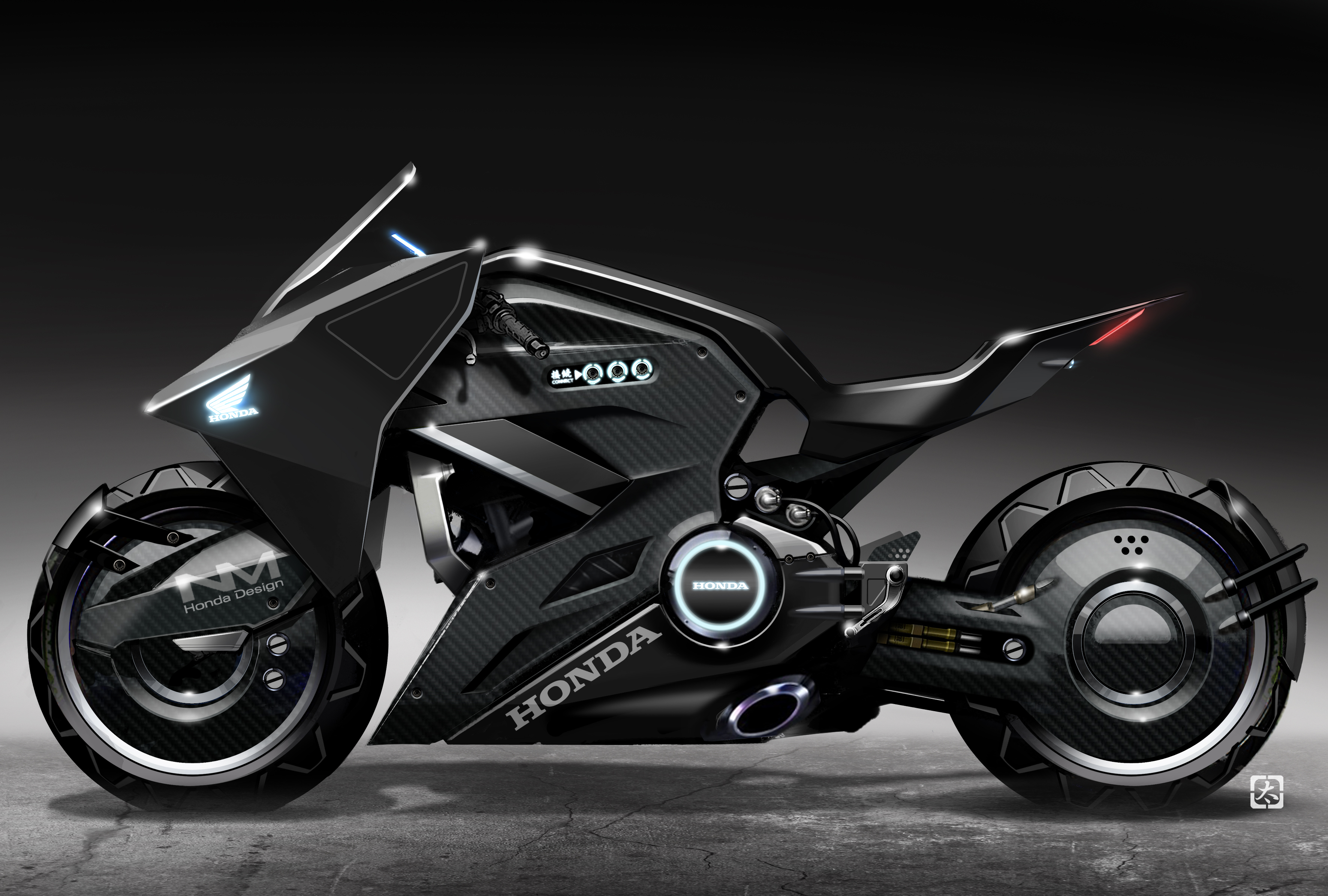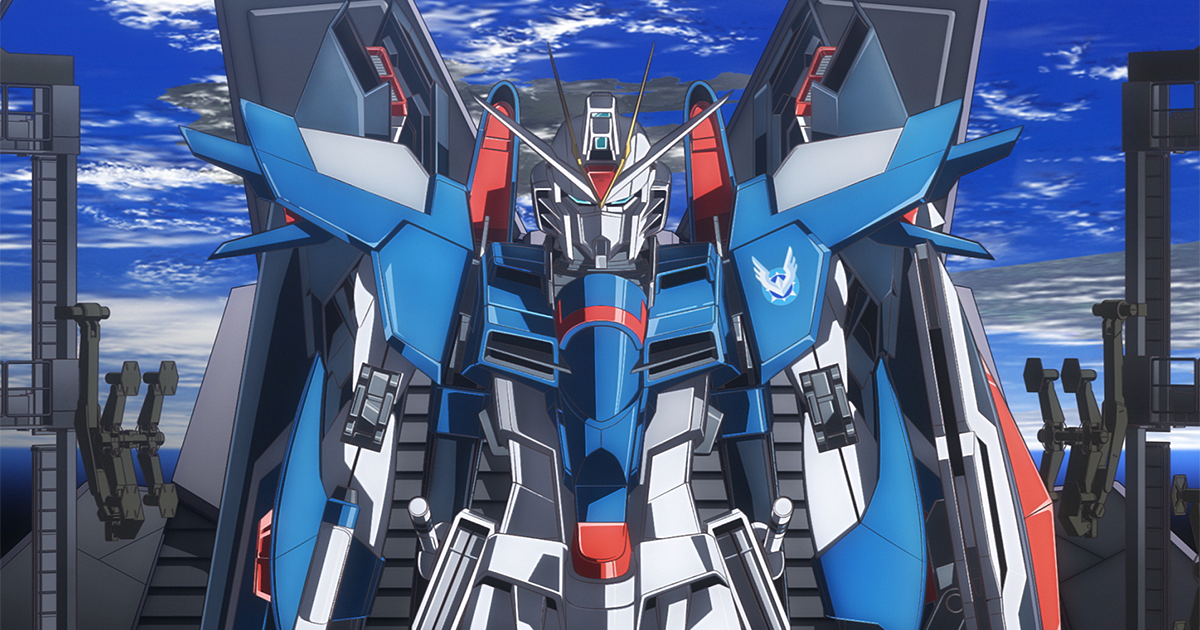The Kamen Rider (Masked Rider) series, GHOST IN THE SHELL, Tokyo Override: Honda motorcycles have appeared in numerous feature and animated films, from children’s hero TV shows to Hollywood sci-fi blockbusters, providing new points of contact with fans.
This issue of Honda Stories delves into the perspectives of Nishimoto, Creative Director/General Manager of the Motorcycle & Powerproducts Design Division, and the motorcycle PR team on their continued contributions to each project, the behind-the-scenes process, and their uncompromising pursuit of realism.

Creative Director/General Manager,
Motorcycle and Powerproducts Design Division,
Design Center,
Honda R&D Co., Ltd.
View More
Close
Taro Nishimoto
Read More
Legacy Honda bikes in Hollywood movies
In the Terminator series, there are scenes in the first, second and fifth films in which main characters ride Honda motorcycles. Honda Motorcycle Public Relations described the appeal of the Honda motorcycles appearing onscreen.
 Spacy 125 Striker (announced 1983), similar model to the bike Sarah Connor rode to work on
Spacy 125 Striker (announced 1983), similar model to the bike Sarah Connor rode to work on
In addition, Arnold Schwarzenegger, who plays the Terminator in the first film, rode the DREAM CB750 FOUR, which was produced for around 10 years from 1969. This model was a big hit both in Japan and abroad, and is known to have originated the term “Nanahan” [seven and a half] describing 750cc models. It was instrumental in solidifying the presence of Japanese-made large motorcycles around the world. It was a relatively inexpensive large model in the U.S. (exchange rate at the time was 360 yen/dollar), yet it was easy to ride, had horsepower, and a powerful sound. It looked good even when ridden by a large man like Schwarzenegger, and its durability and toughness must have been attractive in action films.
 DREAM CB750 FOUR was instrumental in enhancing Honda’s brand image around the world.
DREAM CB750 FOUR was instrumental in enhancing Honda’s brand image around the world.
In Terminator 2, Sarah Connor’s son, John, rides the XR100R off-road bike.
This is a motocross bike with no headlights or blinkers, so it is not supposed to be ridden on public roads. In some areas in the U.S., this is a bike that can be seen loaded onto the back of a pickup truck, to go to nearby deserts for fun rides.
 Well known among some motorcycle enthusiasts, although the XR100R is powered by a 4-stroke engine, in the film it was made to sound like a 2-stroke, which has a high-pitched and distinctive sound compared to a 4-stroke engine.
Well known among some motorcycle enthusiasts, although the XR100R is powered by a 4-stroke engine, in the film it was made to sound like a 2-stroke, which has a high-pitched and distinctive sound compared to a 4-stroke engine.
In Terminator Genisys, the fifth film in the series, Kyle Reese, John Connor’s father, who later becomes the leader of the rebel forces, rode the Road Pal NC50 in the scene depicting his childhood. It is a compact motorcycle designed with the concept of 'even people who have never ridden a bike can ride it.' It feels realistic that the model chosen eliminates the need for clutch operation—often considered difficult in motorcycle handling—making it easier for younger riders to control.
 Road Pal NC50
Road Pal NC50
Sarah Connor, Kyle Reese and John Connor signify two generations of Honda riders in the Terminator series.
Behind the scenes in GHOST IN THE SHELL
GHOST IN THE SHELL was the first Hollywood feature film that Honda officially provided motorcycles to. How did you become involved in designing the bike ridden by the heroin?

In producing a live-action film based on a popular Japanese manga/anime, the producers approached us requesting a model from a Japanese motorcycle manufacturer to be featured in the film. I was working in a different department at the time, and since movie production had already started, I joined the project halfway through when 7 or 8 designers including overseas members were already working on design plans for the bike.
We were short on time, having to complete the first design in about a week. Out of the 10 or so designs we submitted, the producers chose my design.
That was a tight schedule. What difficulties did you face?

In designing the bike, we knew that it would be featured in a live-action film based on the GHOST IN THE SHELL franchise (in Japan), and that Scarlett Johansson would be riding it. We had no information from the production side about how they wanted the bike to look or feel, and no scripts, storyboards, or other materials. They requested that the bike be based on the NM4, which features a unique riding position as if the rider were diving into the cockpit, but more forward-leaning. They also wanted a real, engine-powered bike for real-life filming. With such little information, we drew up design sketches manually. Since we could not include everything in the initial design within the first week, so after they chose my design, we made feasibility adjustments in order to build the actual bike, while including the world view and design they wanted.
How were you involved in production of the bike used in filming?

As Honda, we wanted to cooperate in the process of completing the bike for filming, but due to their budget and time constraints, we only made and transported the base chassis, and the exterior was made near the filming location by a production company that specializes in vehicles for filming. Although the local production company would decide how the bike would appear in the film and what level of quality it would need to be made to, we visited New Zealand twice, once during the production process and once for a final check of the finished bike, and held meetings and discussions.
The bike’s exterior was made locally, but what were the design aspects that you considered?

As the bike was engine-powered instead of electricity, an existing engine would have to be mounted, which would impose considerable restrictions on the layout and other aspects. Since it would actually be ridden by a rider, safety must also be taken into consideration. As a result, we decided to use the NM4 engine as is, but the audience would be disappointed if it were obvious that the bike was engine-powered, considering the film is set in a near-future world. So, it was difficult to design a bike that could be ridden while hiding the engine to some extent, and this was also a key consideration.
For example, we designed the caster angle of the front wheel (tilt of the front suspension) to fit the sci-fi worldview.
Since the angle cannot be changed too much, to ensure maneuverability, we designed the front fenders in a slightly unique shape to make the caster angle appear as if it tilted flat.
 Sideview sketch of NM4-based bike used in GHOST IN THE SHELL
Sideview sketch of NM4-based bike used in GHOST IN THE SHELL
 Top-view design sketch
Top-view design sketch

We also adjusted the dimensions (placement, length, angle, etc.) and size of the body parts to make the bike look best for Scarlett Johansson’s height. We asked a woman of about the same height to sit astride the base bike, and checked the distance between the step and the seat. It is important to make sure that the bike looks good when ridden.
 Taro Nishimoto, Creative Director, Design Center
Taro Nishimoto, Creative Director, Design Center
What is the significance of Honda's cooperating in these kinds of entertainment productions?

The sales volume of motorcycles in Japan has dropped to one-eighth or one-ninth of its peak. Many of the younger generation have few opportunities to see motorcycles and riders in their daily lives. In this environment, as on-demand distribution accelerates online, the power and influence of entertainment to spread awareness has become far greater than in the past. I would be happy if the appearance of Honda motorcycles in such productions triggers their interest.
Similarly, I also want to give the younger generation in Honda this kind of experience. For me personally, participating in this film was a great experience to learn about the film production process and to be exposed to the cultures of other countries. Based on this, as a bike designer I would like to provide as many opportunities as possible for Honda employees to have experiences that are only possible because they work at Honda. I would like to continue to consider such opportunities if they arise.
Honda bikes that power Kamen Rider series
Honda has supported, in various ways such as providing motorcycles, the second season onwards of the Heisei Kamen Rider (Masked Rider) series which began in 2001. What is the significance, and Honda’s passion, in continuing to cooperate with a children’s series in which motorcycles play a major role?
The Kamen Rider series was first broadcast in 1971, and although it ended for a while, was re-launched as the Heisei Kamen Rider series in 2001. The series, which has continued to convey longing, dreams, and justice for half a century since 1971, is one of the prominent series representing “hero culture” that has been passed down from parent to child for three generations in Japan. Honda Motorcycle Japan (HMJ) continues to provide motorcycles to Toei, the producer of the Kamen Rider series, in the hope of “supporting the growth of children to realize their childhood dreams and aspirations.”
Toei and HMJ have a mutual understanding of each other’s approach and culture in entertainment and motorcycles, and have built a cooperative relationship based on mutual respect.
Who selects the motorcycle model provided each year, and from what perspective?
HMJ selects from the popular models in Japan at the time of broadcast. By increasing the number of opportunities for children to see in real-life the actual base models of the bikes that appear in the series, they will be able to experience the bike of their dreams, and their parents’ generation will also become aware of the latest Honda motorcycles.
There are many motorcycle models that Honda has provided to this series.
Many of the motorcycles in the series are based on off-road models such as the XR250 and CRF250L, but Kamen Rider W features the CBR1000RR, a large super sports bike.
 CBR1000RR appearing in Kamen Rider W
CBR1000RR appearing in Kamen Rider W
From 2003 to 2007, the CBR954RR and CBR1000RR raced in the Suzuka 8 Hours endurance race as the Kamen Rider Honda team, from HMJ’s passion to provide an opportunity for “families to enjoy the Suzuka 8 Hours.” The grueling 8-hour race is Japan’s largest motorcycle race, held every mid-summer at the Suzuka Circuit as a round of the FIM Endurance World Championship. We were able to share the excitement with many customers as they watched the Kamen Rider ride boldly race.
 MASKED RIDER Hibiki Honda Racing Team’s CBR1000RR in the 2007 Suzuka 8 Hours
MASKED RIDER Hibiki Honda Racing Team’s CBR1000RR in the 2007 Suzuka 8 Hours
How will Honda cooperate with the series in the future?
Motorcycles are mobility that expand people’s life's potential by providing the joy of mobility, and connecting riders with new scenery and people. We can only continue to experience and ride motorcycles in Japan with the understanding and support of everyone, and HMJ intends to play a central role in continuing our cooperation in order to help revitalize not only Honda but the entire motorcycle industry, and to help energize the dreams of the children who will carry Japan into the future.
Honda’s passion for inspiring future riders through near-future anime
Honda is cooperating with Tokyo Override, a current Netflix animation series, not only in terms of the motorcycles that appear in the film, but also in character profiles and the story’s worldview, which is a new development for Honda.
Around three years ago, Netflix asked us to cooperate in the production of the series. Four people, including two designers, are working on the series.
The story is about a young man who works as a courier in Tokyo 100 years from now, when AI has been integrated into daily life, everything aspect of urban life has been automated, and electric vehicles and self-driving cars have become the standard. ICE motorcycles appear as both a hobby for a small group of people, and a means to mobility freedom, which plays a large role in the courier’s work. We began by asking ourselves, “What kind of motorcycle can we imagine appearing in this world?”
The CB1300SF is one of the Honda bikes that appears in the series. Why was the CB series included in such a future, and what is its appeal?
We imagined the models we hoped would still be around a hundred years from now, and the team felt these were the Super Cub for small commuters, and the CB series for large fan models.
Honda became world famous along with the Super Cub’s popularity, which also improved the image of motorcycles. Honda also created the DREAM CB750 FOUR, which was also featured in the Terminator series as a large motorcycle, which became globally popular. We believe that the CB series is Honda’s signature model, and the DREAM CB750 FOUR was epoch-making as it was a sports bike with an inline 4-cylinder engine, packed with lots of power in a standard design.
 Honda CB1300SF (left) and Yamaha YZF-R1 (right) in the Tokyo Override (Netflix series now streaming)
Honda CB1300SF (left) and Yamaha YZF-R1 (right) in the Tokyo Override (Netflix series now streaming)
What other ways is Honda cooperating in the production of Tokyo Override?
This is a sci-fi series set in Tokyo a hundred years in the future, but to make the ICE bike look real, its sound is vital. So, we assisted by attaching microphones to a real CB1300SF and riding it, and to record at maximum speed used facilities within Honda R&D that simulate high-speed riding. We are, of course, very good at working with actual motorcycles.
What are the advantages of conveying the appeal of Honda and its motorcycles through cooperation in real-life and animated films and TV series?
Such entertainment provides a point of contact for Honda and its motorcycles to children who have never touched a motorcycle and people who are not motorcycle fans. By conveying the quality and appeal of motorcycles through entertainment, we hope to inspire the next generation of children to dream of building motorcycles like the ones they see on the screens.
Thank you very much.








Honda motorcycles have appeared in these films, although we don’t think Honda officially cooperated with the series. In Terminator (1984), Sarah Connor rides a Spacy 125 Striker to work. This was the first Honda motorcycle with a retractable headlight.